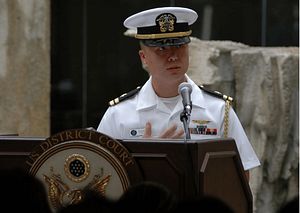A U.S. naval flight officer is under investigation for allegedly passing military secrets to China.
According to USNI News, Lt. Cmdr. Edward C. Lin, a naval flight officer with experience in signals intelligence (SIGINT) aboard U.S. Navy Lockheed Martin EP-3E Aries II reconnaissance aircraft, is facing several charges, including espionage. The charges were described during an article 32 hearing, a provision under the United States Uniform Code of Military Justice offering a preliminary evaluation of evidence before a defendant is referred to a general court-martial. USNI has posted a heavily redacted charge sheet in connection with Lin’s article 32 hearing.
USNI News reports that Lin, who is fluent in Mandarin and had emigrated from Taiwan with his family at the age of 14, managed “the collection of electronic signals from the aircraft [as] a central coordinator.” Additionally, Lin had served from 2012 to 2014 as the congressional liaison for the assistant secretary of navy for finance management and comptroller, according to USNI.
Lin’s case represents the first major incident of espionage by an active duty member of the U.S. Navy since the end of the Cold War. In 1985, the Navy convicted John Walker, a U.S. Navy chief warrant officer, of spying for the Soviet Union for almost 20 years. In Walker’s case, then-U.S. Secretary of Defense Caspar Weinberger attested that Walker’s espionage helped the Soviets acquire “access to weapons and sensor data and naval tactics, terrorist threats, and surface, submarine, and airborne training, readiness and tactics.”
In Lin’s case, the accusations suggest that he may have passed on highly sensitive information about how the United States and its surveillance aircraft gather and process signals intelligence. The intelligence could not only help the Chinese People’s Liberation Army counter U.S. surveillance efforts, but also help China hone its own indigenous platforms, including the Gaoxin-6, a four-engine, fixed-wing, anti-submarine patrol aircraft that bears similarities to the EP-3E Aries II, the P-3C Orion, and the P-8 Poseidon.
The accusations against Lin come at a time of heightened tensions between the United States and China over the South China Sea, where Beijing and Washington have each accused the other of undue militarization. China has reinforced its outposts in the Paracel Islands, including Woody Island, and continued to build and enhance surveillance platforms in the Spratly Islands. Meanwhile, starting in May 2015, the United States began surveillance flights over parts of the South China Sea, partly to test excessive Chinese maritime claims. Beijing has said U.S. operations in the South China Sea, including the U.S. Navy’s freedom of navigation operations and surveillance operations, are evidence of militarization.
Update: The Washington Post, citing a U.S. official, confirms that Lin is actually under investigation for providing military secrets to both China and Taiwan.

































